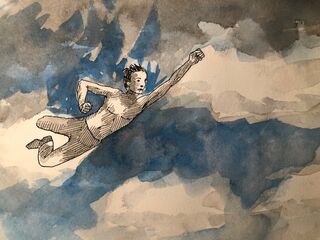Sport and Competition
The Spectacle of Sports
Form, aesthetics, and mass enthusiasm.
Posted February 1, 2021 Reviewed by Lybi Ma
Cellulloid dreams of cellulloid
It eats light and gives life.
As the national ritual of Super Bowl Sunday approaches, let us consider the cult of sports. According to German philosopher Peter Sloterdijk, since the renewal of the Olympic Games in Athens in 1896, sports and such event culture became the main means for eliciting mass ecstasy, or enthusiasm. The founder of the modern Olympic Games, Pierre Coubertin, explicitly saw sports as the secular future of transcendent experiences for the masses. What other forms of spectacle inspire in us such religious fervor? In this essay, I trace how the cult of sport brings into focus the human form.

According to the official Olympics website, “the Olympic Games were the sporting, social and cultural highlight of the Ancient Greek calendar for almost 12 centuries…every four years from 776BC to at least 393AD.” At its height, 40,000 people attended the games. Like everything else in ancient times, it was a religious festival, which included blood sacrifice (100 heifers for Zeus) and copious amphoras of wine. With athletic games superimposed on this frame, thus was born muscle religion. The Olympics remained a Hellenic cultural milestone.
We observe the recalcitrance of such nationalism in what may be the best film ever made about sports, Olympia (1938) by Leni Riefenstahl. With 44 cameras and the full support of the Führer, this riveting 226 minutes of footage achieves a unified sweep from a classical Greek origin story in the ruins of the Acropolis and Olympia to the film capture of the physical perfection of the human form.
Riefenstahl was portraying the Olympic games as an epic of human striving and achievement. Yet, there is something about the form of the mass sporting event through which we observe both the thrill and the danger of mass hysteria, the group psychology essential for fascism and mob violence. Despite its technical virtuosity and aesthetic brilliance, viewing the film now is full of ominous foreboding as the nationalistic pride of the crowd suggests forms of transcendence and identification that would soon be channeled into violence and destruction.
In many ways, Riefenstahl’s approach to sports photography set the template for how sports were to be filmed. From close-ups to slow-motion shots and montage, even her methods of building tension and introducing the function of the announcer all remain paradigmatic. One thing that has been transformed is the erotic nature of her camera. The human body (mostly male) is caressed and ogled in Olympia. This approach is less central to contemporary sports photography, but I would argue that the erotic tension has been transformed into a hype-celebrity form of eros. The sports star is a hero, role model, sponsor, cultural symbol, and physical freak.
Something interesting happens when the media coverage of an athlete becomes more about their character than about what they do. This happened with American tennis player John McEnroe, who in 1984 achieved an almost perfect season. In the Realm of Perfection (2018), a film by Julien Faraut, is a philosophical rumination on the genius of the athlete in the time of sport as a televised spectacle. What we get in this chronicle of the 1984 French Open is a consideration of the psychology of competition.
McEnroe, of course, was the enfant terrible of tennis, known for his childish fulminations at line judges and majestic temper tantrums. This element of his character is depicted in the film as a croque monsieur of madness, genius, and eccentricity. Some spectators found this endearing, leading to identification with the player, but his Cold War bravado played poorly at the hallowed courts of Roland Garros. Willingly or not, in the modern period the athlete is automatically registered into showbiz, where the vicissitudes of spectacle apply to all his actions. Generating enthusiasm through charisma and character is more than ever part of the athlete’s job description.
Four decades after the cool aesthetic comparisons between Greek statuary and the human form in Olympia, the analysis of McEnroe’s performance is undertaken via computer programs that chart his movements. A tennis expert, Gil de Kermadec, analyzes extreme slow-motion shots of the player to understand the perfection of form he achieves on the court. But something strange happens: McEnroe reacts to the cameras, they unnerve him, he develops an uncanny relationship to the apparatus of spectacle which constantly invades the space in which he is trying to achieve complete concentration. Unlike the athletes in Olympia who are all too happy to be filmed (even to reenact certain events, as gold medal pentathlete Glenn Morris did for his lover Riefensthal), McEnroe is menaced by the cameras; the spectacle distracts him from his pursuit of perfect form.
How much spectacle are contemporary athletes liable for? Rather than practicing their craft, is success unduly tied to their capability to secure corporate sponsorship, act in advertisements, and generate hype? On Super Bowl Sunday, we will be treated to 70 cameras, manned or robotic, they will show replays from all angles, markings overlaid on freeze frames, esoteric statistics revealing obscure possibilities and dense histories, commentators stuffed into their suits waxing philosophical about play-action fakes. During halftime, a spectacle of mass enthusiasm will unfold, a medley of cloying popular song lip-sung to accompany fireworks, crowd choreography, pyrotechnics, and erotic costumes.
Creating mass ecstasy and enthusiasm is the predominant pursuit of the spectacle of sport. Despite the incredible amount of training and effort practiced by contemporary athletes, the spectacle has, in general, become more important than the sporting event. On America’s national holiday, Super Bowl Sunday, the aesthetic nuance of Riefenstahl and Faraut will be traded for the blunt mastery of manipulation in marketing, and the country will celebrate the religious rites of capital.
References
Faraut, J. (2018). In the realm of perfection. Criterion collection.
Riefensthal, L. (1938). Olympia. Criterion collection
Sloterdijk, P. (2013). You must change your life: On anthropotechnics. Translated by Wieland Hoban. Great Britain: Polity Press.




